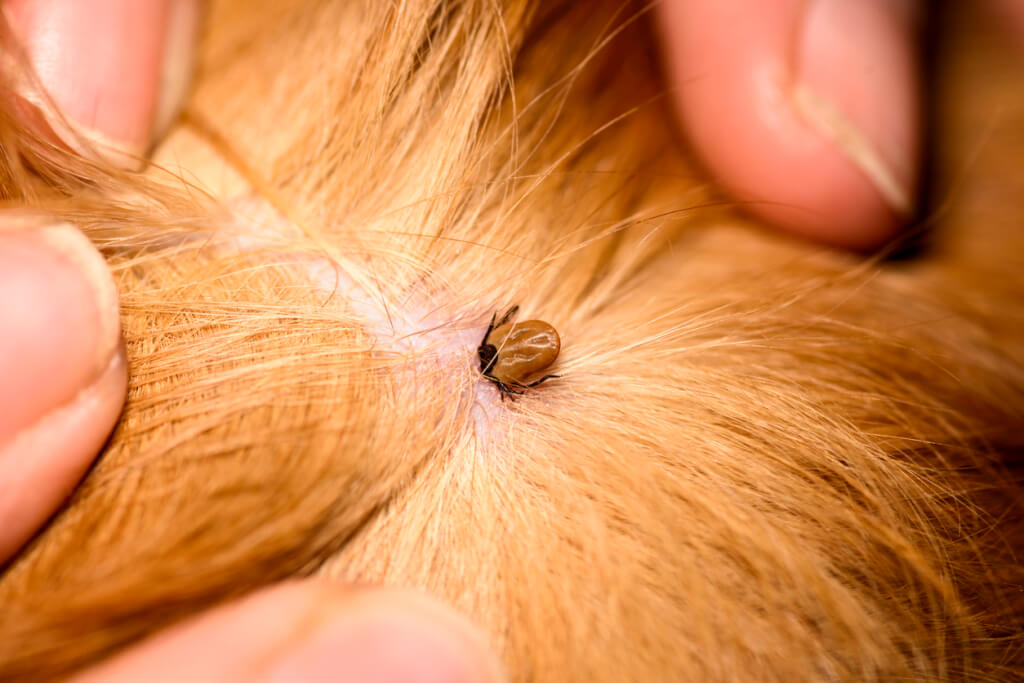How to safely remove ticks from a dog: step by step instructions
If you have a pet, then you need to know about the proper removal of ticks from a dog, treating bites and, first of all, preventing them, reports OutDoorLife.

Photo: IStock
You may already know how to remove a tick from a person, but do you know how to remove a tick from a dog? Every dog owner should have this skill. Because when it comes to removing ticks from your pet, it's a matter of "when", not "if". Every dog will get bitten by a tick sooner or later. Several common types of mites can be found everywhere these days.
“Historically, our ticks have had a certain seasonality,” says Cincinnati veterinarian Dr. Mark Hayes. “In Ohio, we've had cold enough winters that we haven't seen ticks. But now I see them all winter. We actually encounter them all year round.”
On the subject: The first drug completely created by artificial intelligence began to be tested on humans
Most tick bites are benign. But ticks also carry diseases like Lyme disease and Rocky Mountain spotted fever. Whether you have a house dog or one of the hunting dog breeds, it's in your dog's best interest to know how to remove a tick quickly and effectively. You should also know what symptoms of a tick bite to look out for after removing it. Here's what the experts recommend.
Where are ticks usually found on dogs?
While a tick can latch on to any part of your dog's body, some areas are more vulnerable to bites than others. Ticks have a way of crawling into small nooks and crannies that often go unnoticed. There they are likely to feed in peace for several days in a row. Some of these places include:
- in the ears and behind the ears;
- in the armpits;
- between the pads of the limbs;
- between the hind legs;
- in the cheeks or folds of the skin;
- around the eyelids (sometimes mistaken for "eye mass").
Steps to remove a tick
The first rule is to remain calm. This will help your dog not to worry. See if someone else can hold your dog so you can use both hands to find and remove the tick. Double check to make sure what you're looking at is definitely a tick and not a mole. If it has little legs sticking out of its attachment point, it's a different color from your dog's skin, and if your dog doesn't squeal when you pull it, it's most likely a tick.
Tools you will need:
- tweezers or tool to remove ticks;
- a disinfectant, such as antibiotic ointment or hydrogen peroxide;
- an assistant to help keep your dog still;
- headlamp or flashlight (if you have an assistant) in case of low or poor lighting.
Step 1. Take a pair of tweezers or a tick remover.
While you can remove a tick with your fingernails, it's safer to use precision tools, such as a tick killer or Homesake tick remover, if you have access to them. If you try to remove the tick with your bare hands, you risk tearing off the body of the tick but leaving the head (not good). Dr. Hayes says tweezers work too.
Step 2: Hold the coat with your non-dominant hand.
Get as easy access to the tick as possible. If there is excess loose skin in the area, pull it away from the body and pinch well below the tick to highlight the area of the bite, as if you were pulling out a splinter. If the tick is under the ear, bend the ear back to expose the bite as much as possible.
Step 3: Take the tick as close to the skin as possible with tweezers or a special tool.
With luck, you will be able to grab part of the head, ensuring you don't leave it in the skin. Some mites burrow deeper than others, but legs should be visible around the attachment site.
Step 4: Pull straight up to pull out the whole tick.
Pulling with the tweezers at an angle will increase the risk of the body coming off the head. If you pull straight up, the head should gently separate from the skin. Don't expect the tick to come out right away. You may have to stretch a lot. Just be careful not to crush the body of the tick or tear off its head. If you are using a tick removal tool, follow the instructions. Some tools require you to turn the tick or pull to the side rather than straight up to remove it from your dog.
Step 5: Check the bite mark.
Carefully inspect the tick and the wound site. If the tick still has its two-toothed jaw and head attached to its body, and the bite mark doesn't have what looks like a tiny splinter stuck in it, you've pulled out the entire parasite. If part of the tick's head is missing, look at the bite mark to see if you can grab the remaining part. Don't pick too deeply - this will only increase the risk of infection.
Step 6: Disinfect the bite site.
Any over the counter antibiotic ointment or hydrogen peroxide will do the job. If you use hydrogen peroxide on a dark-coated dog, it will likely bleach the coat a bit. You can use an eyedropper to apply if you are worried about a light spot. If you use ointment, apply liberally. Follow the bite mark in the following days.
Like the article? Support ForumDaily!?
A red bump or small rash may appear. As a rule, this is normal and does not immediately mean that the dog has a tick-borne disease. But Dr. Hayes recommends that you still take your dog to the vet to have it checked out.
Do dogs get sick from tick bites?
Diseases carried by ticks are unpleasant and potentially fatal. This should motivate you to remove the tick from your dog as soon as possible. Just like humans, dogs can get Lyme disease, Rocky Mountain spotted fever, and a host of other tick-borne diseases that dog owners should be aware of. Most diseases carried by ticks show similar symptoms in dogs. They can take three weeks or more to appear, so keep a close eye on your dog's behavior.
First, look for signs of a fever. The dog's eyes will turn red, his ears and nose will be hot, and his behavior will become lethargic. If your dog is also exhibiting joint stiffness, lameness, or other behaviors that indicate he is in pain, there is a good chance he is dealing with a tick infestation. Also watch for decreased appetite, lethargy, malaise, diarrhea, vomiting, breathing problems, or any other symptoms.
Potential tick-borne diseases in dogs include:
- Lyme disease;
- canine ehrlichiosis;
- anaplasmosis;
- American spotted fever;
- babesiosis.
Ways to Prevent Tick Bites in Dogs
Pets deserve useful preventive measures. According to Dr. Hayes, the best way to prevent tick bites and subsequent illness in your dog is to talk to a veterinarian and get a prescription for oral medication. Most of these tablets are almost indistinguishable from regular dog treats. They deliver antibodies into your dog's bloodstream that kill any mites that are attached.
"A product like NexGuard that you give your dog once a month won't prevent ticks from getting on your pet, but it will kill them before they can transmit that bacteria," says Dr. Hayes. “These ticks have a hard shell, so they are difficult to kill, but they die quite quickly from medications. I really like Nexguard, but you should talk to your vet.”
Over-the-counter topical preparations also help in prevention. Options range from a monthly ointment like Frontline Plus to a good old fashioned flea and tick collar like Seresto. Unlike oral preparations, these topical preparations act as powerful insect repellents that repel insects. Some even kill fleas, lice and grubs.
Whether you choose the oral prescription or over-the-counter topical option, Dr. Hayes also recommends considering the Lyme vaccine for dogs.
“Be sure to get the Lyme vaccine. The vaccine has few side effects. Then do monthly preventative maintenance, says Dr. Hayes. “Prevention is much easier than trying to cure.”
How long can a tick live on a dog
Once attached, the mites will feed on their hosts for several days before eventually falling off and moving on to their next life cycle. If the tick is a carrier of the disease, transmission of the infection will occur within a few hours after contact with the skin of the animal.
You may be interested in: top New York news, stories of our immigrants, and helpful tips about life in the Big Apple - read all this on ForumDaily New York.
Does hand sanitizer remove mites
While the alcohol found in most hand sanitizers kills mites, it does not help separate them from their host. Save your hand sanitizers, alcohol wipes, and other disinfectants to treat bite marks after you've successfully removed the tick.
What immediately kills ticks on dogs
Oral medications introduce special antibodies into your dog's bloodstream that kill the mites as soon as they attach. Some topical repellents, such as FrontLine Plus and flea and tick collars, kill ticks and other insects on contact.
Can my dog survive a tick bite?
Even if you don't remove the tick before it swells, there's still a good chance your dog will make it through the experience successfully. First, the tick may not be a carrier of any disease. But if the tick has had something nasty and successfully passed it on to your dog, modern veterinary medicine is your best friend. Take your dog to the veterinarian as soon as your dog shows any worrisome symptoms. It could be a swollen bite mark, fever, signs of joint pain, or decreased appetite.
Read also on ForumDaily:
Prigozhin met with Putin after the coup attempt: they discussed 'employment options'
Former FBI Agent Reveals XNUMX Communication Secrets That Will Help You in Everyday Life
Subscribe to ForumDaily on Google NewsDo you want more important and interesting news about life in the USA and immigration to America? — support us donate! Also subscribe to our page Facebook. Select the “Priority in display” option and read us first. Also, don't forget to subscribe to our РєР ° РЅР ° Р »РІ Telegram and Instagram- there is a lot of interesting things there. And join thousands of readers ForumDaily New York — there you will find a lot of interesting and positive information about life in the metropolis.











